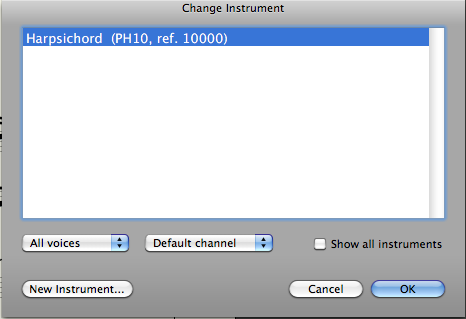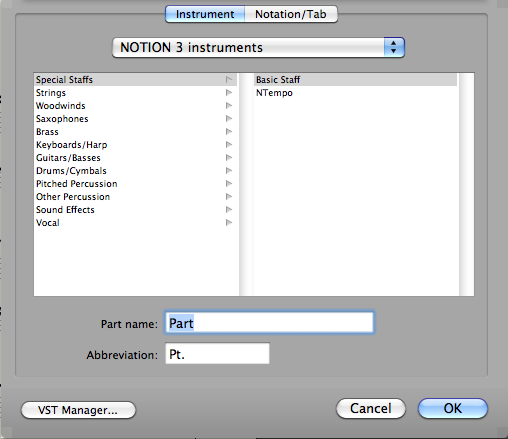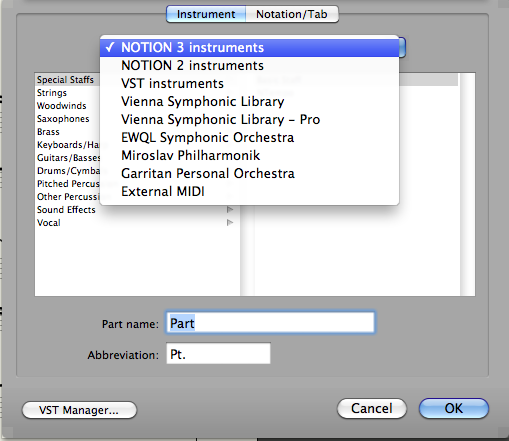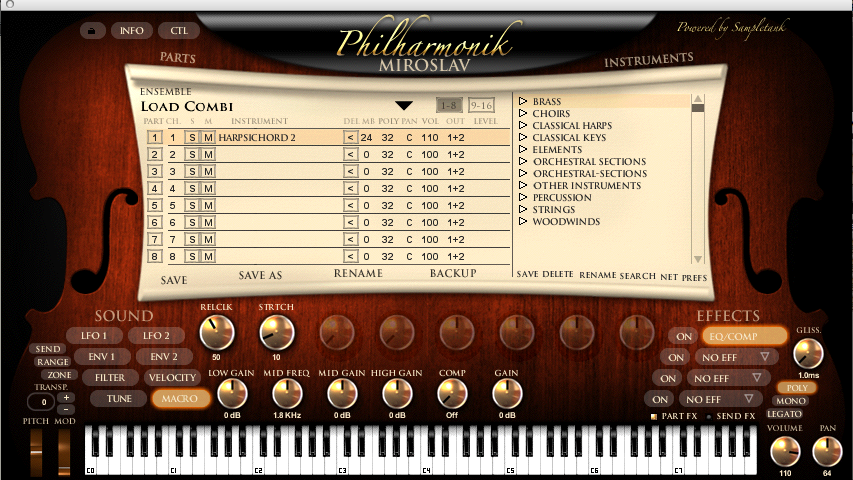achambily wrote:When I want to choose a VST instrument for a staff (clicking on the "bulb light" button on the left), the VST interface is not shown so I can't choose the sounds and make the settings... How can I make the VST interface visible ?
It depends on the type of user interface the VSTi has, as well as whether it has a user interface . . .
For example, as best as I can determine the N2 and N3 VSTi libraries do not have standalone user interfaces, so everything is done via the pop-up dialog box that appears in Score Setup when you click on the "light bulb" icon at the far-left of a staff (as explained in the reply before this one . . .
However, when a VSTi library has a standalone user interface, the rules are a bit different . . .
Specifically, in Score Setup when you first select a VSTi library that has a standalone user interface, the standalone user interface for the VSTi library is launched, and you can make a detailed selection at that time . . .
Later, if you want to modify it, you can switch to Notion 3 Mixer and click on the name of the VSTi instrument at the top of its Mixer track, which launches the standalone user interface for the respective VSTi instrument, with this being the same procedure for viewing and changing a VST special effects plug-in in the Notion 3 Mixer . . .
Nevertheless, this only works for VSTi instruments and VST special effects plug-ins that have standalone user interfaces, which here in the sound isolation studio is the case for the various IK Multimedia products I use (Miroslav Philharmonik, Sample Tank 2.5, T-RackS 3 Deluxe, Xpansion Tank 3) . . .
Yet another strategy is to add a new instrument in Score Setup, where you can set it initially as you desire . . .
And there is another way to do it, which begins by clicking somewhere on a staff in music notation view, followed by doing the doing a "Shift plus I" hotkey, where you hold the Shift key and then press the capital "I" key, which causes the following pop-up dialog box to display (where even though I am on the Mac, I mostly am using Windows terminology, since I learned nearly all this stuff decades ago when I first started doing Windows software engineering) . . .
 Change Instrument ~ Step 1
Change Instrument ~ Step 1If you click on "New Instrument", then this pop-up dialog box appears . . .
 Change Instrument ~ Step 2
Change Instrument ~ Step 2If you click on the "Instrument Tab" at the top of the pop-up dialog box from Step 2, then a list of available VSTi libraries is shown, and you can select one of them by clicking on the respective list item . . .
 Change Instrument ~ Step 3
Change Instrument ~ Step 3The rules for making the standalone user interface appear for a VSTi library vary, but the easy way to do it is to switch to the Notion 3 Mixer, where you can click one time on the name of a track and if the track represents a VSTi instrument which has a standalone user interface, this will launch the standalone user interface for the VSTi instrument, where the following track is labeled "Hrp.", which is the abbreviation for "Harpsichord 2" in Miroslav Philharmonik . . .
 "Hrp." Track in Notion 3 Mixer
"Hrp." Track in Notion 3 MixerIf you single-click on "Hrp." at the top of the Notion 3 Mixer track in the label with the solid black background, then the standalone user interface for Miroslav Philharmonik is launched, since in this example the "Hrp." track is a VSTi instrument from Miroslav Philharmonik . . .
 Miroslav Philharmonik (IK Multimedia) ~ Standalone User Interface
Miroslav Philharmonik (IK Multimedia) ~ Standalone User InterfaceSo, there are several ways to change a VSTi instrument, and this is the way it works on the Mac, which probably is similar to the way it works on Windows machine, although some of the hotkeys and shortcuts might be a bit different . . .
[
IMPORTANT: If you are using "heavy" VSTi libraries and "heavy" VST effects plug-ins, it is very important to save your work frequently, because there is a limit to the amount of "heavy" VSTi instruments and VST effects plug-ins that Notion 3 can handle simultaneously, which in my testing on the Mac tends to happen somewhere in the range of 20 "heavy" VSTi instruments with perhaps 5 or so "medium" VST effects plug-ins and one "heavy" VST effects plug-in, which is fine with me, since I work on a song using instrument subsections where each instrument subsection is a separate Notion 3 project file (a.k.a., "score"), where for example I have a separate Notion 3 project file for percussion, which has a few common instruments to provide reference points, but otherwise only has percussion instruments. And I do the same thing for counterpoint instruments, melody instruments, "sparkles", and so forth and so on, which requires a bit of planning and a sensible working strategy, but this is easy to do if you have worked on computers for a while and happen to be a rocket scientist, otherwise it probably is a bit mind-boggling, but so what . . . ]
Overall, I have no immediately conscious idea how Notion 3 or anything else works in Windows Vista and Windows 7, and I make an effort not to remember how everything works in all the other versions of Windows, so my observations apply primarily to Notion 3 on the Mac . . .
As noted in other posts, some of which are separate topics, over the past 7 months I have devoted great attention to learning how Notion 3 works, as well as how Notion 3 interacts with Digital Performer 7 (MOTU) and a virtual festival of VSTi instruments and VST effects plug-ins, as well as Reason 5 (Propellerhead Software), MIDI, ReWire, and so forth and so on . . .
There are a lot of special rules and somewhat strange procedures, but I have devised a very nice system that makes it possible to have at least 1,000 Notion 3 instruments, all of which can be "heavy" VSTi instruments, and I can get them into Digital Performer 7 as soundbites via ReWire, with the caveat that since Digital Performer 7 cannot handle 1,000 tracks it is necessary to merge tracks into soundbites, which basically is the digital universe analog of Phil Spector's "Wall of Sound" technique, as well as the way George Martin did multiple track work with the Beatles, where in the beginning the Beatles were recorded on two-track analog magnetic tape machine and George Martin essentially used variations of the techniques that Phil Spector devised, although people other than Phil Spector knew about this, where for historical accuracy the best information I have is that Les Paul was the person who used the technique first in an elaborate way, although I recall hearing some early records that were made by playing a previously made record and recording the previously made record while playing additional instruments, where in this context "record" refers to Edison style platters or cylindrical disks, so from this perspective I think that people have been "overdubbing" for a long time, which most likely started soon after Thomas Edison invented the first phonograph . . .
This a YouTube video that provides an overview of the way Les Paul did the recording for "How High The Moon" (Les Paul & Mary Ford), which for the hit record he did on January 4, 1951 nearly a decade before Phil Spector created the "Wall of Sound", and as best as I can determine this was done on some combination of 1-track and 2-track analog magnetic tape machines that Les Paul had Ampex modify with additional playback and recording heads, which considering that this technology was very new at time is mind-boggling . . .
http://www.youtube.com/watch?v=rITJyZVTfy4Mind-boggling!And in the grand scheme of everything, the important aspect of this type of recording system, be it analog or digital, is that it is practical, reliable, stable, and repeatable, which certainly is the case with Notion 3 and Digital Performer 7 on the Mac . . .
The reality is that it takes a while, but if you step back a few paces and consider everything from a common sense perspective, the fact of the matter is that creating 1,000 instruments and composing music notation for all of them takes a while no matter how you do it . . .
If it takes an hour or two per instrument to do it with Notion 3 and the aforementioned software in the digital universe, I suggest that this is considerably faster than doing it with real instruments, and it certainly costs less than hiring 1,000 musicians and singers, which makes it very practical . . .
Initially, it takes longer than a few hours, but this mostly is a matter of learning how to use Notion 3 and all the other software, as well as devising a system for doing everything . . .
Once you have devised a system for doing this type of work and are reasonably proficient in all the various software, then the work takes less time, for sure . . .
And if your focus is on discovering how to do state-of-the-art Pop songs, then the reality is that there is a tremendous amount work done on Pop songs at the dawn of the early-21st century, really . . .
Really! As best as I can determine, major record labels have teams of folks working on different aspects of Pop songs for their artists, and I think it is quite reasonable to suggest that vocal recording and processing takes hundreds of hours of work by a vocal producer and a team of audio engineers, all for one Pop song . . .
For example, if you listen very carefully with studio quality headphones like the SONY MDR-7506 (a personal favorite) to the European single for "Who Owns My Heart" (Miley Cyrus), it is not difficult to determine that there are somewhere in the range of 50 to 100 vocal tracks, special vocal effects, and so forth and so on, although depending on how finely trained your hearing is, it might require listening to the song 50 to 100 times, if not perhaps several hundred times, for sure . . .
http://www.youtube.com/watch?v=iVbQxC2c3-8For sure! With respect to hearing everything, it is helpful at first to watch the music video for a Pop song, since this makes it easier to determine when what you hear simply does not match the mouth motions of the singer, but overall the best strategy is to listen Pop songs while wearing studio-quality headphones in the dark over and over and over . . .
And the overall goal is to learn all the instrumental and vocal parts "by ear" to the point that you pretty much can "see" the entire score in your mind in real-time, which for most folks takes a while to learn how to do, with this being a bit more difficult to do until you learn how to do things "by ear" rather than in the formal universe of music notation, really . . .
On the other hand, some folks discover how to do all this stuff over a weekend, but so what . . .
So what! No matter how you do it, I think it is grand FUN, which is fabulous . . .
Fabulous! 
P. S. I did a bit more work on what I call the "basic rhythm section" for "Feel Me" (The Surf Whammys), which is the song "inspired by" the European single for "Who Owns My Heart" (Miley Cyrus), which is coming along nicely, although I need to revise the Tubular Bells, Vibraphones, and a lot of the Latin percussion instruments, really . . .
[
NOTE: This a bit on the "hot" side with respect to volume level, since I "pumped" it with T-RackS 3 Deluxe, and everything is done entirely within Notion 3. There are 46 instruments at present, most of which are "heavy", as well as perhaps 10 VST effects plug-ins, one of which is "heavy", and this is at the upper limit of what Notion 3 can handle, to the point that if I add one more VSTi instrument or VST effects plug-in, then Notion 3 crashes, so I am splitting this single Notion 3 project into several subsection clones, which is the practical way to do everything, since it needs at least 100 additional instruments, some of which will be "sparkled", where the "sparkles" require perhaps another 200 or so instrument tracks. And this is a headphone mix . . . ]
http://www.surfwhammys.com/Feel-Me-1-26-2011-Extended.mp3Really! 





